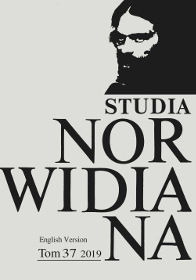The eagle from Rzecz o wolności słowa
Abstract
The article attempts at explaining the motif of the eagle which appears in the final Song XIV in the poem Rzecz o wolności słowa. Previous scholars have unambiguously associated this symbolic vision with the apocalypse and with the figure of St John. The reading of Volney’s Travels through Syria and Egypt, supported by the source description of Palmyra’s ruins from Robert Wood’s The Ruines of Palmyra, otherwise Tedmor, in the Desert (1753), points rather to an archaeological source of Norwid’s imagery – the image of the ruins of the Palmyrene Temple of the Sun (Baal).
References
Chlebowski P., Cypriana Norwida „Rzecz o wolności słowa.” Ku epopei chrześcijańskiej, Lublin 2000, p. 276.
Merdas A., Pieśń i boleść, [in:] eadem, Ocalony wieniec. Chrześcijaństwo Norwida na tle odrodzenia religijnego w porewolucyjnej Francji, Warszawa 1995, pp. 138-159.
Stefanowska Z., Norwidowski Farys, [in:] eadem, Strona romantyków. Studia o Norwidzie, Lublin 1993, pp. 119-143.
Trznadel J., Czytanie Norwida. Próby, Warszawa 1978.
Volney C.F., Rozwaliny, czyli uwagi nad rewolucjami narodów, Vols. I-II [s.l.] 1794.
Volney C.F., Podróż do Syrii i Egiptu. Odbyta w roku 1783, 1784 i 1785. Z dwiema mappami i 4ma kopersztychami przez P. Volney, Vols. I-II, trans. R. Markiewicz, Kraków 1803.
Volney C.F., Voyage en Syrie et en Égypte, pendant les années 1783, 84 et 85, quatrieme édition, Vols. I-II, Paris 1807.
Volney C. F., Les Ruines ou méditation sur les révolutions des empires, Paris 1826.
Wood R., The ruins of Balbec, otherwise Heliopolis in Coelosyria, London 1757.
Copyright (c) 2019 Studia Norwidiana

This work is licensed under a Creative Commons Attribution-NonCommercial-NoDerivatives 4.0 International License.





